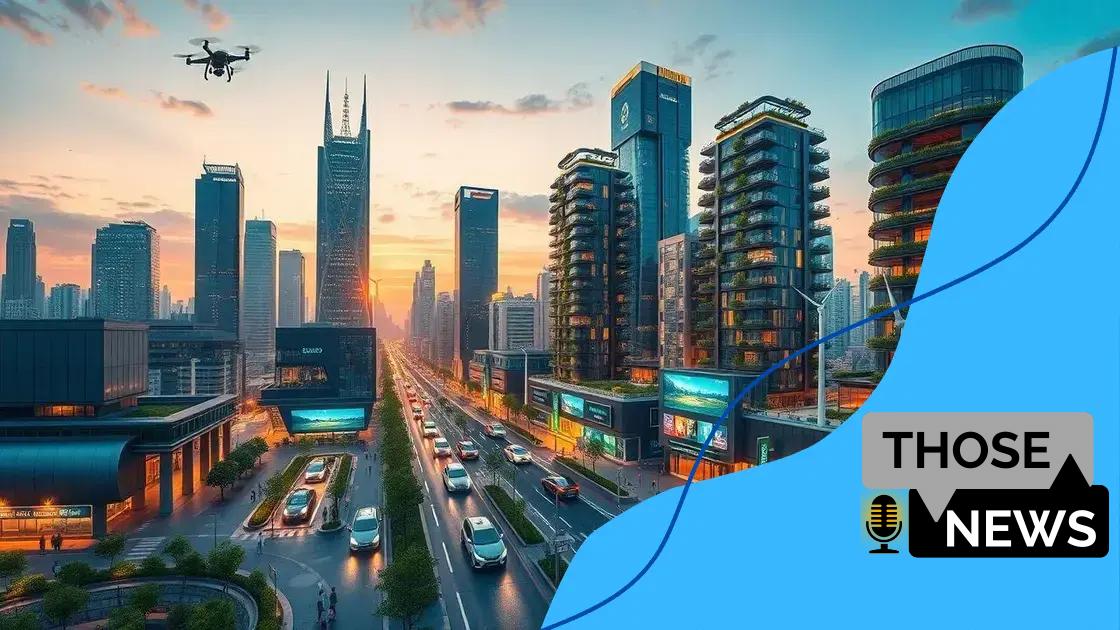Smart city initiatives and energy efficiency: improve your life

Smart city initiatives focus on enhancing energy efficiency through innovative technologies, community engagement, and sustainable practices, addressing challenges like data privacy and outdated infrastructure to improve urban living.
Smart city initiatives and energy efficiency are changing the landscape of urban life, making our cities more livable and sustainable. Have you ever wondered how these efforts impact your daily experiences? In this article, let’s dive into the fascinating world of smart cities and the energy solutions driving them.
Understanding smart city concepts
Understanding smart city concepts is essential for grasping how technology improves urban living. A smart city uses digital technology to enhance performance and well-being. These innovations connect people, data, and resources to create efficient systems.
One key aspect is the integration of IoT devices. Sensors collect data on everything from traffic patterns to energy consumption. This data helps city planners make informed decisions that improve everyday life.
Key Components of Smart Cities
Smart cities combine various technologies. Here are some important components:
- Connected Infrastructure: Roads and buildings equipped with sensors to monitor conditions.
- Public Transportation: Smart systems that provide real-time updates for commuters.
- Energy Management: Smart grids that optimize energy use and reduce waste.
A strong community is vital for a successful smart city. Citizen engagement through online platforms encourages feedback and collaboration. This involvement helps shape the city’s direction, ensuring it meets residents’ needs.
Environmental Impact
Smart city initiatives also focus on sustainability. Reducing carbon footprints is a priority. For example, green buildings use fewer resources and produce less waste. Electric public transport options are being implemented to decrease reliance on fossil fuels.
In essence, grasping smart city concepts gives insights into how technology can enhance urban life while promoting sustainability. These cities aim to create a better, more connected environment for all.
Key benefits of energy efficiency in cities
Energy efficiency is a crucial aspect of modern urban development. Implementing energy-efficient practices in cities not only reduces costs but also greatly benefits the environment and enhances residents’ quality of life.
One major advantage is the reduction in utility bills for both households and businesses. When cities adopt energy-saving technologies, like LED streetlights and energy-efficient buildings, they significantly lower energy consumption.
Environmental Improvements
Inefficient energy use leads to higher carbon emissions. By improving energy efficiency, cities can combat climate change effectively. This leads to cleaner air and contributes to better public health, as fewer pollutants are released into the atmosphere.
- Lower Greenhouse Gas Emissions: Energy-efficient technologies emit less CO2.
- Improved Air Quality: Reducing emissions leads to healthier environments.
- Encouragement of Renewable Energy Sources: Energy efficiency creates demand for green technology.
Another benefit of energy efficiency is its positive impact on job creation. As cities invest in energy upgrades, they create new jobs in sectors like construction and engineering. This investment boosts the local economy.
Enhanced Infrastructure
Smart energy management systems are another component that adds value. These systems monitor energy use in real-time, allowing cities to make adjustments to optimize consumption. This not only conserves energy but also enhances the overall infrastructure of the city.
In addition, community engagement is crucial. When residents are involved in energy efficiency programs, they are more likely to adopt sustainable practices at home. This collaborative approach fosters a culture of sustainability that benefits everyone.
Innovative technologies driving energy savings

Innovative technologies are at the forefront of enhancing energy savings in cities. These advancements not only reduce energy consumption but also improve the overall sustainability of urban environments. By adopting new technologies, cities can achieve significant progress towards their energy efficiency goals.
One notable innovation is the use of smart meters. These devices provide real-time data on energy usage, enabling both utility companies and consumers to monitor and manage their energy consumption effectively. Smart meters help identify energy waste, allowing for informed decisions to be made about energy-saving practices.
Adaptive Lighting Systems
Another breakthrough is the implementation of adaptive lighting systems for streetlights. These systems adjust brightness based on the time of day or the presence of pedestrians and vehicles. This results in considerable energy savings and enhances safety in urban areas.
- LED Technology: LED lights consume significantly less energy than traditional bulbs and last longer.
- Motion Sensors: Streetlights equipped with motion sensors turn on only when needed, reducing electricity use.
- Smart Control Systems: Cities can remotely control and monitor lighting systems, optimizing energy efficiency.
Building automation systems also play an essential role. These systems regulate heating, ventilation, and air conditioning (HVAC) automatically based on occupancy and ambient conditions. This means significant energy reduction as systems adjust to real-time needs rather than running continuously.
Renewable Energy Integration
The integration of renewable energy sources is another innovative approach to energy savings. Solar panels, wind turbines, and other renewable technologies contribute to energy self-sufficiency in urban areas. When cities harness local renewable resources, they significantly reduce their reliance on fossil fuels.
Battery storage technology complements renewable energy use. It allows cities to store excess energy generated during peak production times for use during high-demand periods. This capability not only stabilizes energy supply but also maximizes renewable energy utilization.
Community engagement in smart city projects
Community engagement is vital for the success of smart city projects. When residents actively participate, their input leads to better urban solutions. This involvement creates a sense of ownership and ensures that the needs of the community are met effectively.
One effective method is through public meetings. These gatherings allow residents to voice their concerns, ideas, and aspirations regarding urban development. Engaging the community in this way fosters transparency and builds trust between city officials and residents.
Digital Platforms for Participation
Many cities are now using digital platforms to reach out to their communities. Apps and websites enable residents to share feedback quickly and conveniently. This approach helps collect diverse opinions and ensures that everyone has a voice.
- Surveys and Polls: Online surveys gather input on proposed projects, helping to shape development priorities.
- Social Media: Platforms like Facebook and Twitter allow real-time interaction and updates on ongoing initiatives.
- Project Websites: Dedicated sites provide information and receive community feedback on specific projects.
Participatory budgeting is another innovative way to involve the community. Residents can have a say in how certain portions of the city budget are spent, prioritizing projects that matter most to them. This democratic process enhances community trust and strengthens civic engagement.
Building Partnerships
Collaboration with local organizations is also crucial. Schools, non-profits, and businesses can partner with city officials to drive engagement. These partnerships expand outreach efforts and create more inclusive environments for all community members.
Ultimately, effective community engagement in smart city projects leads to improved urban planning. Cities that prioritize community input can create solutions that are not only innovative but also responsive to the needs of their residents, paving the way for vibrant and sustainable urban environments.
Challenges and future of smart cities
The challenges and future of smart cities are critical topics that need attention. As cities evolve, they face obstacles that can hinder their progress toward becoming truly smart and efficient. Understanding these challenges helps pave the way for innovative solutions.
One major challenge is ensuring data privacy and security. With many devices collecting data, cities must protect citizens’ information from breaches. This involves implementing robust cybersecurity measures and transparent data policies to build trust with residents.
Infrastructure Limitations
Another significant barrier is the existing infrastructure. Many cities have outdated systems that require substantial investment to upgrade. This can slow down the implementation of new technologies and make it difficult to adopt smart solutions.
- Financial Constraints: Many municipalities struggle with limited budgets for technology investments.
- Technological Integration: Older infrastructure may not support new smart technologies seamlessly.
- Regulatory Challenges: Compliance with various regulations can complicate the introduction of new technologies.
Furthermore, the digital divide poses a challenge. Not all residents have equal access to technology and the internet. Ensuring inclusivity requires cities to invest in infrastructure that provides equitable access to all citizens.
Looking Ahead
The future of smart cities hinges on collaboration among stakeholders. Governments, private companies, and residents must work together to share ideas and resources. Public-private partnerships can lead to innovative projects that address pressing urban issues.
Additionally, as technology continues to advance, we can expect more innovative solutions. The rise of artificial intelligence, for example, will enhance data analysis and decision-making, resulting in more responsive city management.
To ensure a successful future, cities must also embrace sustainability. Integrating green technologies and practices into city planning can help tackle environmental issues while enhancing residents’ quality of life.
In conclusion, as cities strive to become smarter and more efficient, understanding the challenges and envisioning the future are paramount. Ensuring data privacy, upgrading infrastructure, and bridging the digital divide are vital steps. Collaboration between stakeholders is essential in creating inclusive smart cities. By embracing innovative technologies and sustainable practices, urban areas can enhance the quality of life for all residents. The future of smart cities is bright, full of potential for impactful change and growth.
\n\n
\n
FAQ – Frequently Asked Questions about Smart Cities
What are common challenges faced by smart cities?
Common challenges include data privacy concerns, outdated infrastructure, and ensuring equitable access to technology for all residents.
How can community engagement improve smart city initiatives?
Community engagement allows residents to provide input on projects, ensuring that their needs are met and fostering a sense of ownership.
What role does technology play in smart cities?
Technology drives efficiency and innovation in smart cities, with solutions like smart meters, adaptive lighting, and renewable energy integration.
Why is sustainability important for the future of smart cities?
Sustainability helps reduce environmental impacts, enhances quality of life, and promotes healthier urban living by integrating eco-friendly practices.





